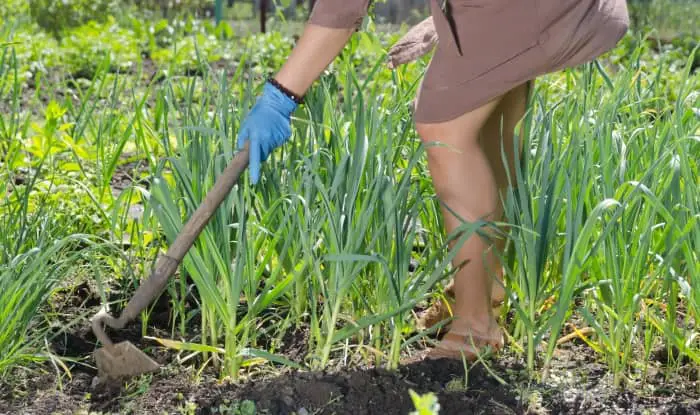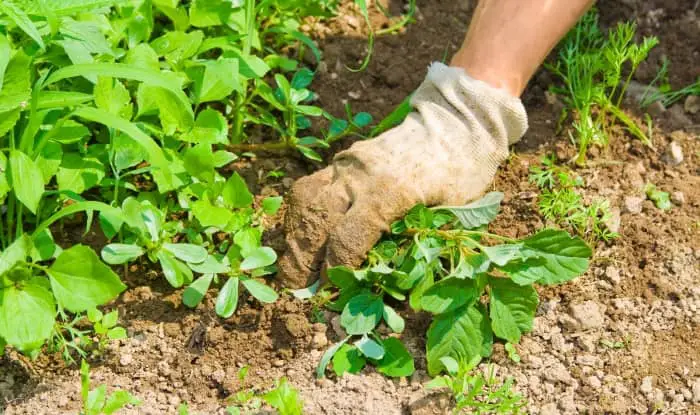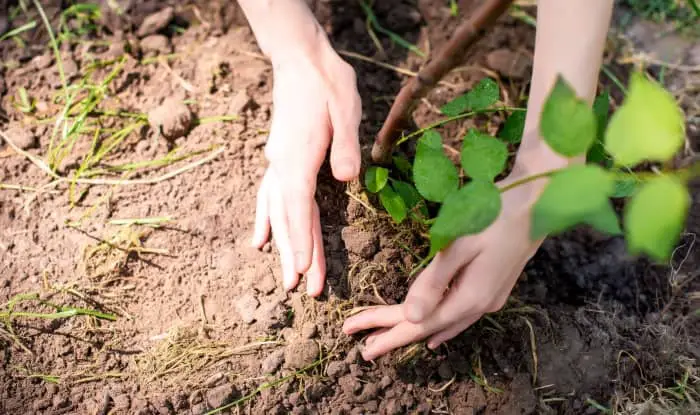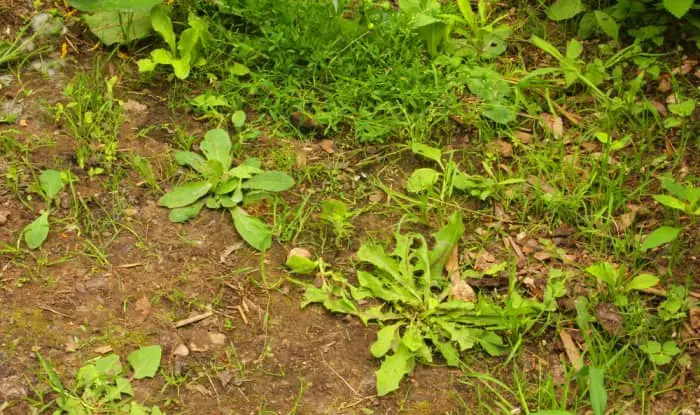Dealing with weeds can seem like a fight that never ends.
No matter how hard you try they just keep coming back.
It would be great to treat an area once and never have to worry again.
But, unfortunately, it’s not quite that easy.
You see, getting rid of weeds permanently can be done, but there’s a catch:
The only way to keep them permanently gone is to permanently work at it.
The good news is it doesn’t have to be a struggle. There are methods that will make your life a lot easier.
Let’s dive in.
What Are Weeds?

Put simply, a weed is a wild plant that’s growing somewhere you don’t want it to be.
It could be a plant that’s sprung up uninvited in your flower beds. Or a different type of grass that’s trying to take over your lovely lawn. And it’s certainly those tufts of grass that are sprouting through your driveway or between the cracks in your patio.
You can classify weeds into 2 types depending on their life span: perennials and annuals.
Perennials can live for more than one year, surviving the winter, and growing from established root systems. And they can be difficult to get rid of.
Why? Because even if you kill the visible part of the weed, they keep growing back if the root system is still alive.
Examples of perennial weeds include dandelions, purslane, plantain, and ground ivy.
In contrast, annuals live and die in the same year. But unfortunately, this doesn’t make them any easier to deal with.
Because even if you manage to get rid of them from your garden, they grow back again each spring from seeds left behind the previous year. These are often blown by the wind or deposited by birds and are impossible to keep out of your garden.
Crabgrass, henbit, and chickweed are common examples.
How To Kill Weeds Permanently

There are many things you can try to keep weeds at bay. But whatever you choose, the only way of keeping an area permanently clear is to take consistent action.
Nature is relentless. And there’s no once-and-done solution to a weed problem.
But fortunately, there are ways to keep them under control while minimizing your work.
Let’s take a further look:
Prevention
If you don’t want a constant battle with weeds it’s worth thinking about weed prevention.
It takes a bit of planning in advance. But it makes a big difference. When done correctly, it can leave you with only occasional spot treatment to keep an area weed free.
These are the main methods you can try:
Mulch
One of the easiest and most environmentally friendly ways to control weeds is to put down a nice layer of mulch.
A 3-6 inch layer is enough to prevent light from reaching the soil, which will prevent many weed seeds from germinating. At the same time, it still allows water and nutrients from the mulch to transfer into the soil.
But it’s not really suitable for laying down on lawns, driveways, or paths.
To inhibit weeds and provide nutrient rich soil for your plants, try using natural materials such as compost, chopped leaves, and bark.
Weed Preventers
Weed preventers prevent the germination of weed seeds in the soil. They come in 2 different types: organic and chemical.
Corn gluten meal is the ingredient used in most organic weed preventers. It raises the level of protein in the soil which can inhibit the root development of newly germinated seeds.
Weed preventers can work well when used properly. But you have to time their use just right. Put them down too early or too late and they won’t prevent germination.
For this reason, it’s a good idea to identify the weeds you’re struggling with. Understanding the season of active growth and the temperature at which the weed type germinates will help you choose the right time to act. This will give you the best results.
Herbicides that can prevent weeds from sprouting are also described as pre-emergent. They sometimes include chemicals that control specific weeds, such as crabgrass.
Weed Barrier Fabric
Another completely natural method for preventing weed growth, weed barrier fabric (landscape fabric) is often recommended for use in ornamental gardens around weeds and shrubs. You can use it under pavers and gravel to prevent weeds from growing through paths and walkways.
When using fabric, you usually cover it with a layer of mulch. And the combination of the two prevents weed seeds from taking root in the soil. At the same time, they deny light to seeds that are already in the ground.
A word of warning though:
Not everybody likes this method, and the reports of results are mixed. Some people find that it can be difficult to remove weeds that do manage to grow through the fabric. And although the fabric is permeable, some gardeners feel that it can prevent adequate amounts of water and nutrients from reaching the soil.
Residual Weed Killers
Some chemical weed killers have a long-lasting action in the soil that prevents plants from regrowing for many months. They are known as residual weed killers.
Because they prevent everything from growing you don’t want to use these on areas where you’re planning to plant.
But they can be a good option for controlling weeds on hard surfaces where you don’t want any vegetation at all.
However, due to their potent and long-lasting action, most chemical herbicides that linger in the soil for a long time are only available to professionals and are not easily obtained by home gardeners.
There are still choices though. With some commercially available weed killers claiming long-lasting action.
On Hard Surfaces

Weeds can appear between the cracks in many places where they’re not wanted. Driveways, patios, gravel, paving stones, foundations, and walls.
The good news is that you have a wide range of options for permanently getting rid of weed problems on driveways and other hard surfaces.
Chemical Weed Killers
Because you want all vegetation killed on hard surfaces it’s easy to find a powerful, non-selective weed killer that will do the job.
Glyphosate is a common chemical that kills plants to the roots, helping to prevent their regrowth.
By Hand
Yes, it can be time-consuming and awkward to dig the weeds out of paving stone cracks. But it’s easier if you use a weeding tool.
And once you’ve got rid of them all you can fill in the gaps with polymeric sand to stop them coming back.
Related: How To Kill Weeds Between Pavers
Vinegar Based Weed Killer
You can spot treat patches of weeds with vinegar. There are many commercial products available that use a 20% acetic acid solution. This is good at killing and disintegrating weeds it comes into contact with. But it won’t always prevent their regrowth unless it affects the roots.
Flame Torch
An easy and, dare I say it, fun method to kill weeds on hard surfaces is to use a propane vapor torch. You can get ones that are specially designed for killing weeds.
Then it just takes a quick stroll around the affected area incinerating each tuft of weeds you stumble across.
On Lawns

Controlling weeds on lawns can be tricky as you have to selectively target the weeds without causing damage to your grass. This is made even more complicated by the fact that some of the weeds you want to get rid of are invasive grass species.
Consider the following options:
Chemical Weed Control
Unlike hard surfaces, where you just want a weed killer that’ll kill everything, you have to be more specific when choosing a product for lawns.
It’s a good idea to identify the weed types you’re having a problem with. Then you can find a product that will selectively target them. For example, you can get weed killers for lawns that will kill all broadleaf weeds and crabgrass.
A word of caution though:
Some grass species, such as St. Augustine, are easily damaged, even by selective herbicides. So be careful when choosing a product for lawn care to make sure it’s okay for your type of grass.
Weed Preventer
Not all pre-emergent weed killers work well on established lawns. But some do, and they’re a great option for weed control.
The one disadvantage of using them on your lawn is that they will prevent any new grass seed from germinating as well. So make sure you don’t use it on areas you plan on reseeding over the following 2-3 months.
Weeding By Hand
If you want to kill weeds without causing much damage to your lawn then doing it yourself is still one of the most effective methods there is.
Just make sure that you completely remove the roots, because many weed species will regrow if you leave them behind. Even if you think they’re dead.
Unwanted Vegetation

Other unwanted vegetation that can be classed as weeds includes trees and bushes.
Some species of weed trees, and bushes such as brambles, are aggressive colonizers if left unchecked and can take over your garden.
The key here is to find them early when they’re easy to remove before they establish deep root systems. Then you can do the job by hand.
Weed killers containing glyphosate can also be used to kill small shrubs.
But if your problem weed turns out to be a tree then it might require a different approach to deal with the problem. You can find out more in our article about Weed Trees.
More Natural Weed Control Methods
Don’t fancy doing it by hand?
But also don’t want to use a chemical weed killer in your garden?
Here are some natural methods that are easy to get started with:
Salt
Watering weeds with a salt solution is a cheap and effective to kill weeds in your yard.
It changes the balance of water in their cells, dehydrating them and leading to death.
So why isn’t it more popular?
Well, there’s just one problem: it doesn’t only kill weeds. And if not applied carefully it also makes the soil unsuitable for anything else to grow.
This makes it a good choice for using on patios, driveways, and sidewalks – any area where plant life is unwanted.
But not such a great choice for ornamental gardens and lawns.
If you do choose to try it in areas where you’re growing other plants, try using a funnel to direct the saltwater onto the target weeds.
And make sure you use a weak solution with around a 3:1 ratio of water to salt to start with. Observe your results and increase the strength if necessary, being careful not to overapply to areas of soil.
Boiling Water
Another method is to douse the weeds in boiling water.
Needless to say, this will kill grass and everything else you pour it on. Making it okay to use on the cracks between patios and driveways. But a poor choice for using on your lawn.
Sometimes you might have to apply the water a number of times to kill particularly stubborn weeds.
It has the significant drawback of being very hazardous. For obvious reasons, you always have to be very careful when handling boiling water.
Vinegar
One of the most popular natural methods of killing weeds is to use vinegar. It’s surprisingly effective.
There are many commercial organic weed killers that use it as their main ingredient. Although they usually use a 20-30% acetic acid solution rather than the 5% acetic acid commonly used with food.
It won’t always get rid of weeds permanently. Sometimes they grow back again. But it’s an easy and convenient method of spot treating.
Vinegar is non-selective. So you’ll have to be careful where you use it, as it will kill all plants that it comes into contact with. But it doesn’t translocate to the roots, so any accidental spray that drifts onto nearby plants will only cause a small amount of damage.
Ideally, get a 20% acetic acid if you can, as the weeds will disintegrate a lot faster. But it can still work with 5%, it just might take more applications.
Whether you use a commercial product or make your own using 20% acetic acid, remember to wear protective clothing when you use it to spray weeds. Because it’s an acid it can cause skin irritation and burns if it gets on your skin.
Here is a homemade weed killer recipe that you can try:
Homemade Vinegar Weed Killer
Ingredients:
- 1 gallon of vinegar
- 1 tablespoon of dish soap
- 1 cup of salt
Instructions:
- Pour the vinegar into a large container.
- Add the salt and soap to the vinegar and stir until fully dissolved and mixed.
- Carefully pour into a spray bottle using a large plastic funnel.
Final Thoughts
What kills weeds permanently?
Unfortunately, there is no once-and-done solution.
The only way to keep an area clear is to use consistent action.
But if you plan ahead you can minimize the amount of work this takes.
It’s easier on hard surfaces as there are many powerful weed killers that will completely kill all vegetation, such as Roundup. Often preventing regrowth for many months.
Lawns and flower beds can be more challenging, and require the use of selective weed killers or doing it by hand to get rid of existing weeds.
Prevention is particularly useful. And it’s a good idea to think ahead and use a weed preventer that will reduce the amount of weeds you have to deal with.
Combining weed prevention with the occasional bit of spot treatment can usually eliminate your weed problem, or at least reduce it to a manageable level.


I dug my weed yard by shovel..laid down weed fabric, topped it off with a bark layer..only to realize that crabgrass does not mind weed fabric, as it vine-spread and took over the yard!
My wife and I live rural. In front of our property there is a ditch that is 60 feet long and 2 feet deep. We have used Round Up. killed some. I spread Vinegar and salt. Killed some. I dropped 100 pounds of Rock Salt, didn’t kill any thing, so I go out and buy a good propane flame thrower. Killed everything. Great for about 2 weeks. Everything grows back. This is just a problem and I know other people must have the same one. I thought you would get a kick out of all this. Very potent weeds my wife and I must grow out here.
What type of vinegar do you use?
Hi Christine,
You can use horticultural vinegar.